Top 15 Most Interesting Places to Visit in Berlin
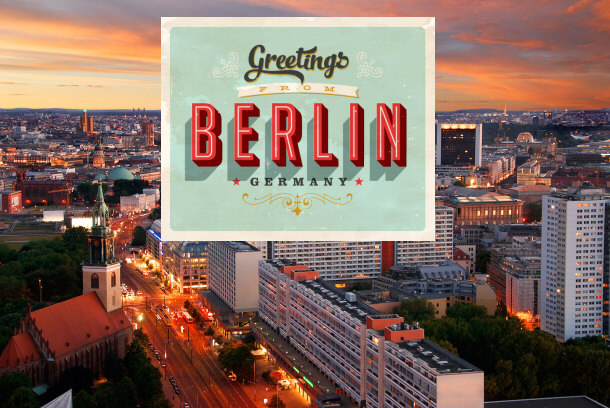
With 3.3 million inhabitants, the capital of Germany is also its most
populous city. However, what the numbers do not show is the incredibly rich
history of the city, dating back to the 13th century, when the oldest available
records mention the small settlements of Spandau and Kopenick. The official
founding date of Berlin proper is considered to be 1237, when the settlement of
Colln on Fischerinel is mentioned in an official document. The real
transformation for Berlin came with the industrial revolution in the 19th
century. With the burgeoning economy and population, the city eventually became
the capital of the German Empire in 1871 and only thrived from that point
onward. Even the ruthless rule of the Nazis and the devastation wrought by World
War II did not manage to break the city, which is now one of the cultural,
political, and economical centers of united Europe. In order to catch a glimpse
of the rich history of Berlin, make sure to visit the following 15 places.
15) Brandenburg Gate
The most iconic architectural feature of the city should be the first place you
visit when in Berlin. The Brandenburg Gate, built in the 18th century on
commission from King Frederick William II of Prussia. The gate was
intended to be a sign of peace, symbolizing the values represented by the
Kingdom of Prussia. Of note is the fact that it was not intended to be a part of
the city's extensive network of fortifications. Rather, it was one of the
eighteen gates leading into the city and part of the so-called customs wall
surrounding it. As the city grew, the Gate was gradually absorbed into the
growing organism.
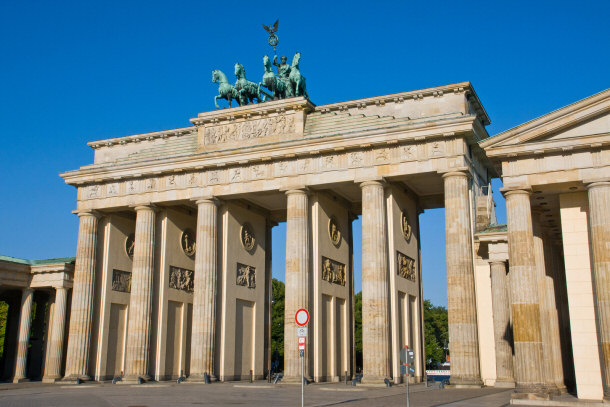
The Brandenburg Gate remains an important piece of the history of the city.
It served multiple political roles in its lifetime, but perhaps none are more
important than it being a symbol of the divided Berlin. When the German
Democratic Republic was formed and Berlin was divided into two halves, East and
West, the Brandenburg Gate remained closed to visitors due to its proximity to
the demarcation line and the famous Berlin wall. Ironically, both governments
cooperated in a joint effort to restore the Gate and remove the damage caused by
fighting in the city of Berlin. Visiting the Brandenburg Gate now is easy, as it
is closed to vehicle traffic and remains an exclusively pedestrian zone.
14) Reichstag
The symbol of German governance, the Reichstag began construction in 1884, years
after the unification of Germany and after two separate contests intended to
provide a design for the building. The Reichstag was finally completed in 1894.
Since then it has become an important landmark in the landscape of Berlin and
played witness to important events in the nation's history. For example,
following the destruction of World War I, the Weimar Republic was proclaimed at
the Reichstag. Less than two decades later, the Reichstag was destroyed in a
fire, giving the ruling Nazi party the excuse to suspend constitutional
freedoms. During the war, it became a priority target during the battle of
Berlin, due to its symbolic value. Finally, after the war, despite repairs, it
was laid to the sideline due to its proximity to the Berlin Wall.
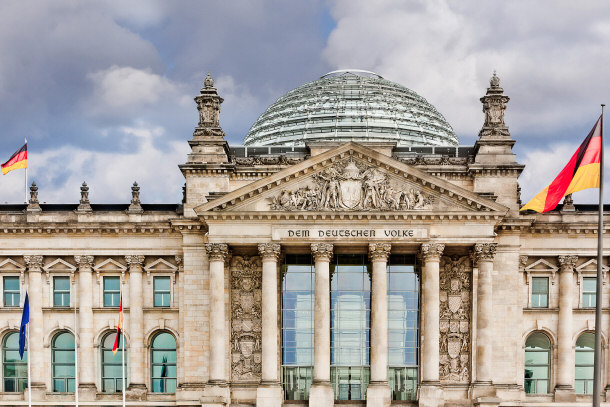
Now, the Reichstag is the official seat of the Bundestag, the German
parliament, and one of the city's most often visited landmarks. While the
architectural and historical value of the building is obvious, one of the key
attractions is the large glass dome crowning the Reichstag, which offers a
breathtaking view of Berlin, especially when viewed at night. Do note, however,
that visiting the Reichstag dome requires prior registration, due to the volume
of visitors. Walk-ins are turned away.
13) Victory Statue
One of the most striking elements of Berlin's skyline is the bronze statue of
Victoria. Erected in 1873, the statue was originally meant to commemorate the
Prussian victory in the war between Prussia and Denmark. However, in the time
frame between the designing of the monument (1864) and its actual erection,
Prussia had won further wars against Austria and France, unifying Germany. The
bronze statue of Victoria was added to signify these victories. The monument was
originally located at the Republikplatz in front of the Reichstag. However,
during Hitler's reign, it was relocated to its current location as part of
preparing Berlin for redevelopment into Welthauptstadt Germania, a monumental
capital of the Third Reich. Although these plans never materialized, the statue
was not returned to its original location at the end of World War II.
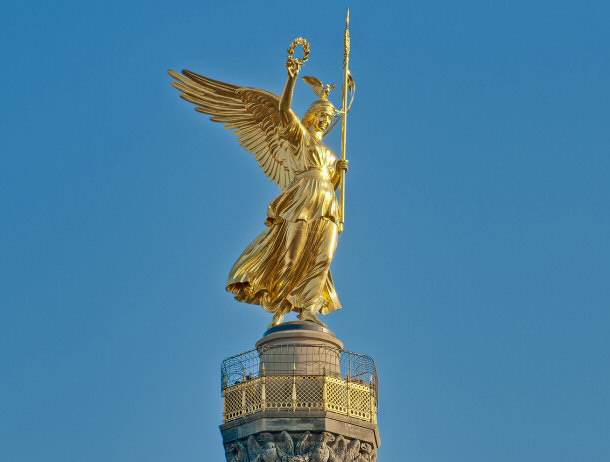
However, apart from being a part of Germany's history (and of Berlin itself),
the statue is worth visiting for another reason. The terrace immediately beneath
the statue is open to visitors from 9:30 to 18:30. Even if you happen to come
too early or too late, the Statue is worth paying a visit, as the base upon
which it rests is an artwork in itself. The polished red granite forms a hall of
pillars featuring a beautiful glass mosaic. And every moment you're there, it's
worth remembering that this monument to past glory was nearly demolished by the
French Army, until the British and American leaders intervened and vetoed the
plan.
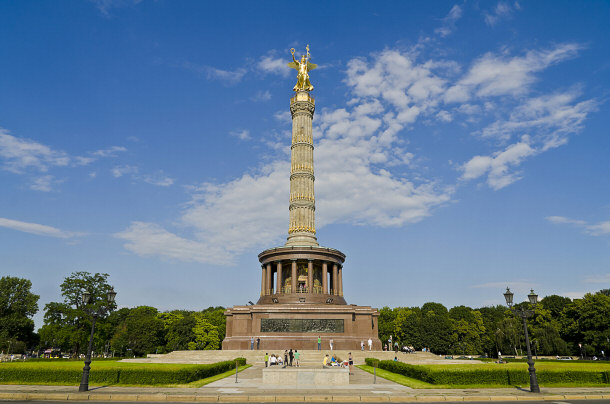
12) Alexanderplatz
Commonly referred to by Berliners as Alex (no, Berliner is not a donut, with or
without the article), Alexanderplatz is one of the largest public squares in the
city and a vital transportation hub. Originally a cattle market right outside
the city's ring of fortifications, the square was revitalized by the growth of
infrastructure in Berlin, eventually becoming a center of nightlife for the city
by the 1920s. Although damaged during the war, it did not suffer the fate of
Potsdamer Platz and was redeveloped and revamped by German Democratic Republic
which controlled it. Since the German reunification, the square has undergone a
gradual evolution, but retains its principal landmarks.
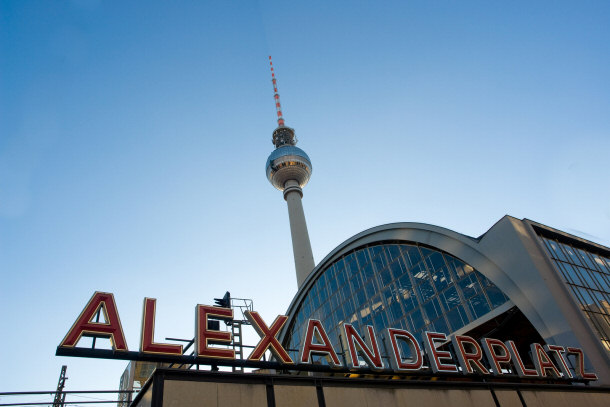
Perhaps the most striking of these is the Fernsehturm Berlin, the Berlin TV
Tower. It is the tallest structure in Germany and the fourth tallest structure
in Europe. The sphere on the tower is open to visitors, featuring a sightseeing
platform and a revolving restaurant in the middle of the sphere, allowing for an
unparalleled vista of Germany's busiest city. And if you're particularly daring,
you can try reaching the sphere on your own by way of a staircase with exactly
986 steps. The only limitations are imposed by the tower's design. Due to the
construction of the lifts shuttling visitors to and from the sphere, wheelchair
access is impossible.
11) Olympiastadion
A landmark connected to Germany's darkest period, the Olympiastadion is one of
the largest Olympic stadiums in the world. The reason is simple. As Germany was
chosen to host the 1936 Summer Olympics, Adolf Hitler intended to use this event
for propaganda purposes. The Olympiastadion was the centerpiece of a monumental
sports complex dubbed the Reichssportfeld (Reich Sport Field), built
specifically to demonstrate the grandeur of Germany and promote the Nazi regime.
It was also the first time that such an event was broadcast globally via
television. The defeat of the regime and the collapse of Nazi Germany did not
spell doom for the stadium. In fact, it survived the final battle of Berlin with
only minor damage due to machine gun fire.
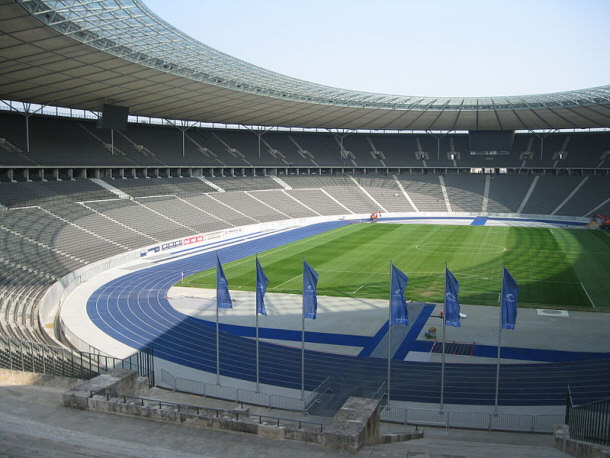
Following the war the stadium continued to be used for sport purposes,
including introducing baseball and American football to the German audiences.
The ultimate fate of the stadium was a matter of some controversy, as the Nazi
past of the massive structure kept returning like a bad dream. Ultimately, the
decision was made to renovate the stadium instead of tearing it down, to
preserve its architectural value. The massive grounds surrounding the
Olympiastadion are freely accessible, as is the hall of columns surrounding it.
Visiting it is worth it, if only to see what's one of the finest examples of
monumental architecture, regardless of its historical context. If you're lucky,
you may also happen to visit Berlin during a concert at the stadium. It's an
experience worth every Euro.
10) Charlottenburg
Palace
On the polar opposite of the Olympiastadion lies Schloss Charlottenburg. It is
the largest palace in Berlin and Germany, as well as the sole remaining royal
residence of the Hohenzollern dynasty. Historical context aside, it is also one
of the most refined examples of baroque and rococo styles, surrounded by a vast
garden with numerous buildings that once served the royal family of Prussia.
Although it was damaged during World War II, like much of Berlin, it was
restored and is currently one of the most prominent attractions in Berlin.
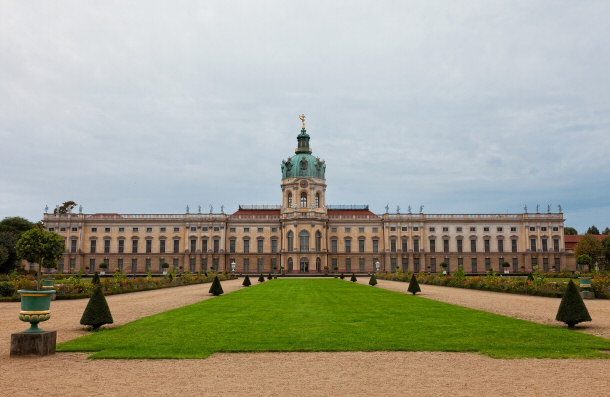
The best part? The gardens surrounding the Palace are free for everyone to
visit and explore, with no admission tickets, except for the mausoleum holding
the graves of the Hohenzollern family, the Belevedere, with its rich Berlin
porcelain collection, and the Neue Pavilion, which functions as an art gallery.
However, visiting the Palace itself is mandatory if you enjoy architecture. For
the price of an admission ticket you receive access to the Alte Schloss (Old
Palace) and the Neue Flugel (New Wing), which are full of exhibitions, including
the crown jewels of the Prussian royal family.
9) Spandau Citadel
Military service was always an important part of the German culture and as such
German states and Germany itself remained at the forefront of military
technologies for centuries. Why is that important? Zitadelle Spandau is one of
the best-preserved Renaissance fortresses in Europe, coming from an era when
firearms entered widespread service, creating a revolution that forced
architects and fortress builders to radically rethink the way fortifications
were built. The Spandau Citadel is one of the finest examples of this
revolution, built in a star-shaped pattern with four protruding bastions
designed to create killing zones for infantry storming the walls and preventing
them from taking advantage of cover provided by fortresses of old.
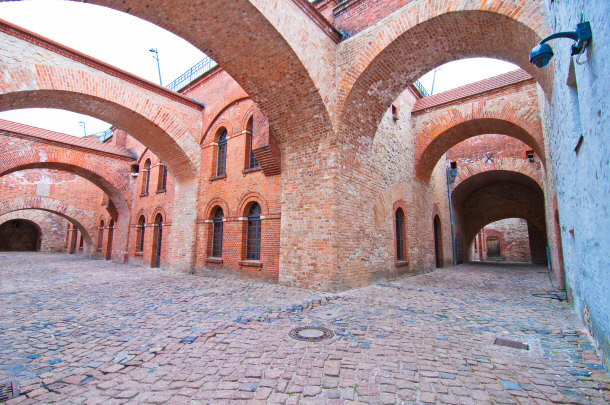
Currently, the Zitadelle Spandau is in retirement, after centuries of service
up to and including World War II. It serves multiple purposes now, from being a
museum of military history with focus on the Citadel itself, to hosting cultural
events like the Citadel Music Festival and numerous concerts in its unique
Gothic Hall. Even if none of these interest you, paying a visit to the Citadel
is worth it, if only to explore the massive fortress that once protected the
town of Spandau. It's a part of the city's rich history and a tangible example
of the evolution of military technology.
8) Berlin Wall
Memorial
However, if you are interested in history, there's one often overlooked location
you should definitely visit. The Berlin Wall Memorial is an area dedicated to
preserving a segment of the Berlin Wall, as a monument to the division of
Germany by the Soviet Union and the DDR regime. The wall first began
construction in 1961, in order to stop German emigration westward and avert the
brain drain that left East Germany deprived of a significant part of its working
population. During the construction of the wall, army and militia units were
stationed at construction sites with orders to shoot anyone who attempted to
cross into West Berlin. When the wall was completed, the borders between East
and West Germany officially closed.
Both sides of the Berlin Wall with the "death strip" in
between
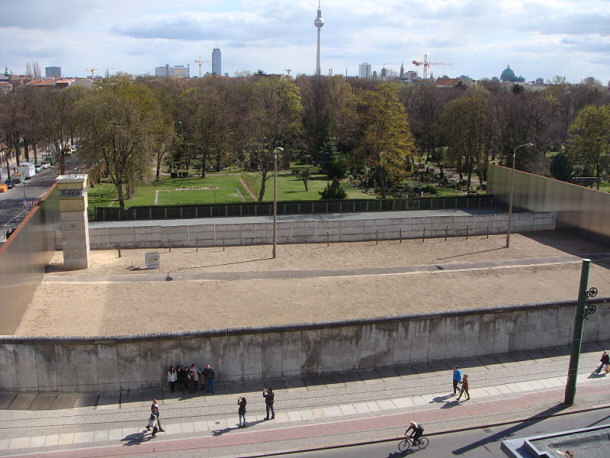
By Karen Mardahl (Tourists at the Berlin WallUploaded by Palnatoke) [CC-BY-SA-2.0],
via Wikimedia Commons
The wall started as a simple wire fence, later upgraded to an improved one by
1965, then a concrete wall by 1975, and finally the Grenzmauer 75 (Border Wall
75), which was the most sophisticated form of the inner German border. Between
two concrete walls a death strip was established, with watchtowers, bunkers,
barbed wire, and other security measures intended to prevent escape into West
Germany and separate the West from the East. The Berlin Wall Memorial preserves
a large segment of this fourth generation Berlin Wall nearly completely intact,
giving a glimpse into how life in the shadow of the wall must have felt like.
7) Checkpoint
Charlie
Of course, the isolation of West Berlin was not total. There existed several
crossings between the two parts of Berlin, with perhaps the most well known
being Checkpoint Charlie. Located at the junction of Zimmerstrasse, Mauerstrasse,
and Friedrichstrasse, it became one of the symbols of the division of Germany
due to its prominence: it was the most visible of the border crossings. During
nearly forty years of its operation, it was the site of numerous events with
perhaps the most intriguing being the October 1961 Berlin crisis, when American
and Soviet tanks engaged in a standoff at Checkpoint Charlie. Separated by just
a hundred meters of open ground, two groups of ten tanks each squared off for
one full day, loaded with live munitions. Thanks to nimble political maneuvering
by President Kennedy, a crisis was averted.
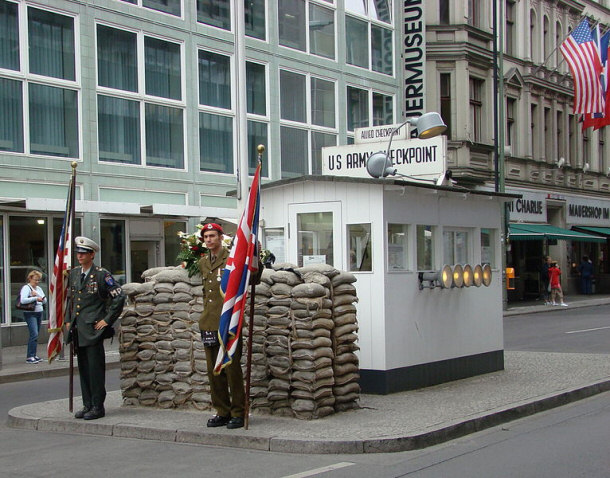
By Hajotthu (Own work) [GFDL or CC-BY-3.0],
via Wikimedia Commons
Today, Checkpoint Charlie has been converted into an open air museum of the
history of the Berlin Wall and the Checkpoint itself. It's a good starting point
for learning more about this period of German history and, more importantly, the
history of Berlin during the Cold War. The conversion of the checkpoint into a
tourist attraction may be a bit jarring to some, however, and some may prefer
the Berlin Wall Memorial mentioned above.
6) Stasi Museum
One of the most important elements of the communist regime in East Germany was
the Ministerium fur Staatssichercheit (Ministry for State Security), commonly
referred to as Stasi. Formed in 1950, it was the sword and shield of the ruling
party of East Germany. In other words, it was the political police that ensured
the security of the regime. Stasi is notable among other security agencies in
the Soviet bloc for its extensive focus on infiltration, monitoring, and
subterfuge, meant to provide total control over citizens living in East Germany.
When Germany was reunified in 1990, the Stasi was one of the first organizations
to be torn down. Despite attempts to destroy files amassed during its operation,
much of the archives survived, forming the basis for prosecuting Stasi officials
for their crimes.
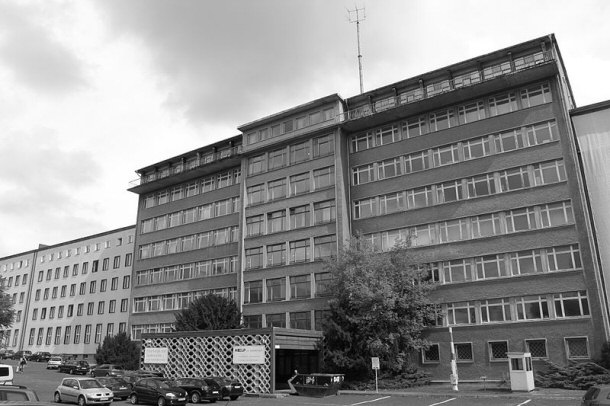
By Prof.Quatermass (Own work) [CC-BY-3.0],
via Wikimedia Commons
After the German population stormed the Stasi headquarters in East Berlin
following the reunification, the building was transferred to a non-governmental
organization, which converted it into a museum giving a glimpse into the
practices of Stasi and life in East Germany. As the East German political police
brought the art of surveillance to near perfection, visiting the museum offers a
terrifying kind of insight into how the police can (and did) operate in a
country controlled by an authoritarian government.
5) Museum Island
For those that want a broader look at history, Berlin also has plenty to offer.
The city's Museum Island is located in the Mitte district on the northern half of
an island in the Spree river. The first exhibition hall was erected at this
location in 1797 and the island's offering of museums has steadily expanded ever
since. Currently, the island is host to five distinct museums that offer some of
the richest collections in the world.
The first two are the Altes Museum and the Neues Museum (Old and New Museum
respectively), which focus on antiquity, featuring collections of artifacts from
Greece, Rome, Egypt, and other significant civilizations of the era. Many of the
artifacts displayed in these museums are unique in a global scale, such as the
bust of Queen Nefertiti. The third museum is the Alte Nationalgalerie (Old
National Gallery), which hosts a large collection of artworks from the 19th
century.
Altes Museum
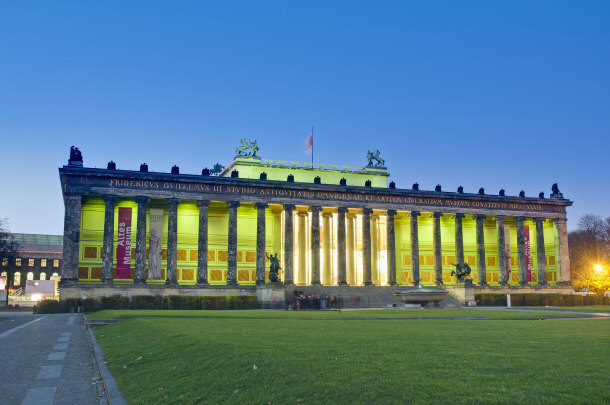
The Bode Museum on the northern top of the island compliments the exhibition
with its large sculpture collection as well as art from the Byzantine Empire and
antiquity. Finally, perhaps the most striking and notable is the Pergamon
Museum. Constructed in 1930, it features reconstructions of famous buildings
from the history of human civilization, such as the Gates of Ishtar and the
Pergamon Altars, built entirely to scale. Note that to truly appreciate what
Museum Island has to offer, a single visit is not enough. Be prepared to spend a
whole day here and still have plenty to see on future trips.
Bode Museum
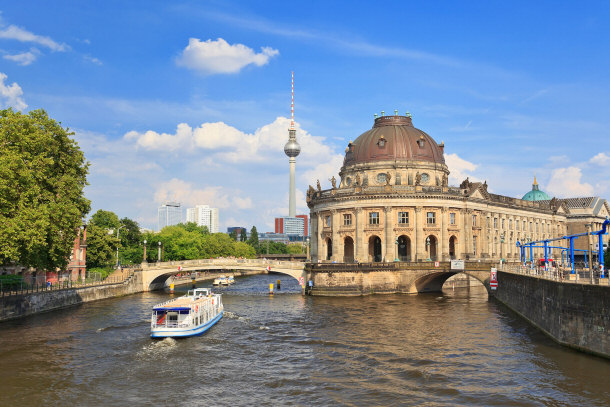
4) Berliner Dom
Of course, visiting the rest of the Museum Island is highly recommended. One of
the most interesting buildings located on it is the Berlin Cathedral. This
beautiful place of worship was officially inaugurated in 1905 by the Prussian
head of state, Wilhelm II. As Germany was a Protestant country, Wilhelm II also
doubled as the head of the state church. The majesty and size of the Berlin
Cathedral was deliberate: it was intended to be the Protestant counterpart to
the Catholic St. Peter's Basilica in Rome. Unlike some landmarks, the Berlin
Cathedral suffered greatly during World War II. Allied bombings of the city
first destroyed the windows and then set fire to the building, causing the roof
to collapse inward.
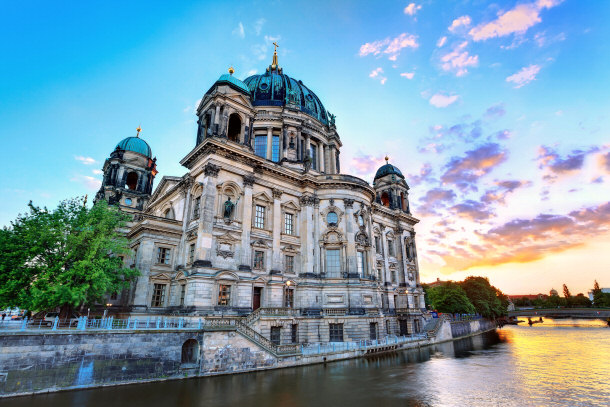
Post-war restoration efforts occurred over the course of several decades,
unhindered by the DDR which controlled the island. The reconstruction of the
destroyed parts of the building was finalized in 1993, when the newly rebuilt
Cathedral was officially re-inaugurated. Currently, the Cathedral is open for
visitors and remains one of the finest examples of the Neo-Renaissance style.
Even if you aren't interested in church architecture, paying a visit to the
Cathedral is worth it due to the gallery located on the church's dome. Located
atop a 270 step climb, it offers a panorama of Berlin from yet another angle.
3) Kulturforum
Of course, for the culture-starved visitor, Berlin has plenty more to offer.
Nowhere is that more evident than at the Kulturforum. Located in the center of
Berlin, a short walk from Potsdamer Platz, the Reichstag, and the Chancellery,
the Kulturforum was once the beating cultural heart of West Berlin and continues
to be an important cultural and artistic landmark in the city and for good
reason: it's host to numerous institutions of culture, including the Neue
Nationalgalerie (New National Gallery), the Museum of Decorative Arts, Berlin
Philharmonic, the Berlin State Library and many more.
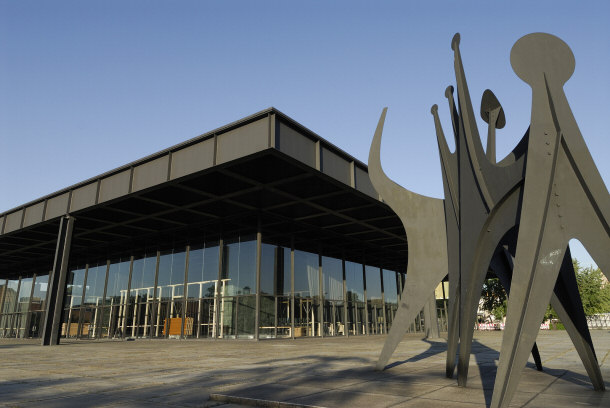
But institutions aren't everything. The Kulturforum is also a very active
concert and festival spot, with plenty of different options depending on the
time of the year. For example, during the summer months the Kulturforum is host
to the Sommerkino: an open-air cinema for up to a thousand guests, playing both
blockbusters and classics in the cool Berlin afternoon.
2) Potsdamer Platz
Located a short walk away from the Kulturforum, Potsdamer Platz is in many ways
Berlin's history in a nutshell. What began as an intersection of country roads
right outside the city's ring of fortifications became a parade ground, then
transformed in the 19th century into a villa district, only to become a large
public square in the heart of the rapidly growing city by the second half of the
century. This hub of commerce and culture was ruined in the battle of Berlin and
then, as if to permanently strike it down, was literally divided in two by the
Berlin Wall, becoming the equivalent of an urban ghost town. This status
extended to the Potsdamer Platz metro station, which became a well known ghost
station.
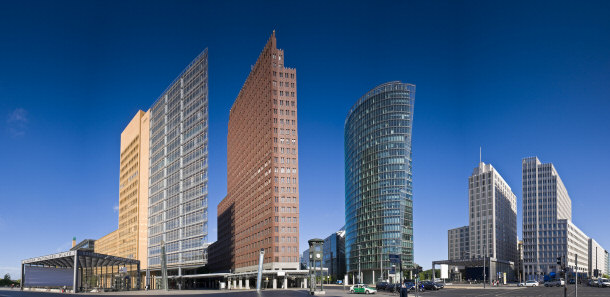
However, with the German reunification in 1990, Potsdamer Platz was brought
back from the dead. The square saw extensive redevelopment, becoming Europe's
largest building site in the 1990s. More than twenty years later it is once more
one of the most important locations in Berlin for finances and shopping. It's
certainly worth a visit, if only to see the German equivalent of the London
City.
1) Berlin Zoological
Garden
Finally, no visit to Berlin should go without a trip to the most popular
zoological garden in Europe. The Berlin Zoo originally opened in 1844 and
currently covers over 34 hectares in Berlin's Tiergarten district. Although it
was almost entirely destroyed during World War II, with its animal population
reduced from nearly four thousand to less than a hundred, it was reconstructed
from the ground up with the aim to recreate the natural habitat of animals
living there as accurately as possible. Currently, the Berlin Zoo is host to
over 1,500 different species of animals and boasts a population of nearly 20,000
animals. It is also notable for its collaboration with schools, universities,
and research institutes throughout the world and is one of the most successful
institutions participating in protecting endangered species.
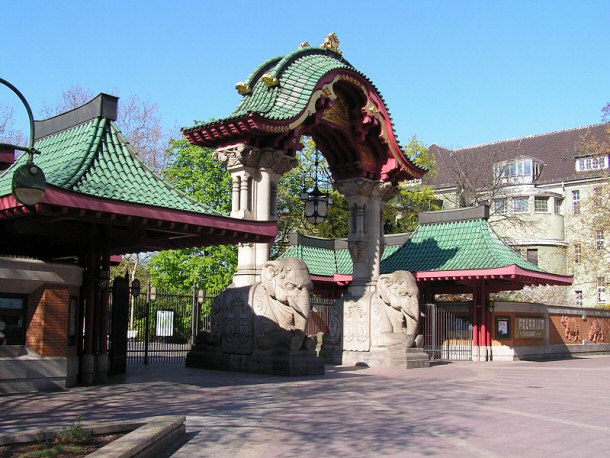
Photo by:
Dieter Brügmann
Of course, with such a diverse number of species, it's best to plan your
visit to the Berlin Zoo ahead. You can expect a fair amount of other visitors,
as the Zoo is Europe's most visited zoological garden, at around 3 million
visitors each year. One of the most interesting features of the Berlin Zoo is
the aquarium, first built in 1913. It is currently one of the top ranked public
aquariums in the world, with one of the most diverse collections of different
marine species, including sharks and corals.
Conclusion
Of course, in a city with such a large population and a rich, diverse history,
there are plenty of other interesting places to explore, ranging from landmarks
that played a prominent role in Germany's long history, to the incredibly rich
night life. The German capital has something to offer to everyone, regardless of
whether they are aficionados of architecture, connoisseurs of culture, or people
visiting to immerse themselves and experience Berlin in general. If you're going
to visit, remember that in such a cosmopolitan city English will suffice, but to
truly show your appreciation for Germany and its citizens, learn even a few
basic phrases in their native language. They like it.
Vacation Destinations
Top Lists:
Top 15 Interesting Places to Visit in the Bahamas
Top 15 Fun Things to Do in Miami, Florida
Top 15 Fun Things to Do in Chicago
Top 15 Best Unknown Things to do in Las Vegas
Top 15 Fun Things to Do in Hollywood
Top 10 Best Places to Visit in Turkey
The Top 15 Best Things to Do and See in Sydney
Top 10 Things to Do in Edinburgh
Top 10 Things to do on Oʻahu
Top 15 Things to Do in Albuquerque
Top 15 Interesting Places to Visit in Spain
Top 15 Places to Visit in New York City
Top 15 Things to Do in Portland Oregon
Top 15 Things to do in Greece
Top 15 Places to Visit in Houston Texas
Top 15 Interesting & Safe Places to Visit in Mexico
Top 15 Interesting Places to Visit in the Netherlands
Top 15 Interesting Places to Visit in Thailand
Top 15 Interesting Places to Visit in Switzerland
Top 15 Interesting Places to Visit in Portugal
Top 15 Places to Visit in San Francisco
Top 15 Interesting Places to Visit in Shanghai
Top 15 Interesting Places to Visit in Puerto Rico
Top 15 Interesting Places to Visit in Norway
Top 15 Interesting Places to Visit in Las Vegas
Top 15 Interesting Places to Visit in Jamaica
Top 15 Interesting Places to Visit in Croatia
Top 15 Interesting Places to Visit in Belgium
Top 15 Interesting Places to Visit in Bangkok
Top 15 Things to Do in Rio de Janeiro
Top 15 Things to Do in Monaco
Top 15 Interesting Places to Visit in Dubai
Top 15 Interesting Places to Visit in Amsterdam
Top 15 Things to Do in New Zealand
Top 15 Interesting Places to Visit in Paris
Top 15 Interesting Places to Visit in Italy
Top 15 Interesting Places to Visit in Singapore
Top 15 Most Interesting Places to Visit in Berlin
Top 15 Best London Attractions
15 Little Known Facts About New York City Disney World Articles
Top 15 Disney World Rides for Adults
Top 15 Disney World Rides for Kids
Top 15 Disney World Resorts for Adults
Top 15 Disney World Resorts for Kids
15 Fascinating Facts About Disney World
Top 15 Fun Things to Do at Disney World’s Animal Kingdom
Top 15 Fun Things to Do at Disney's Hollywood Studios
Top 15 Fun Things to Do at Disney World's Epcot
Top 15 Fun Things to Do at Disney World’s Magic Kingdom
Shorter Top Lists:
Top 10 Tourist Attractions in San Diego
Top 10 Tourist Attractions In India
Top 10 Things to Do In Kansas City
5 Places You Should not Miss in Brazil
Top 5 Things to do in New York City
Informational:
Best Tourist Attractions In Vietnam
Taking in the Sights in Shanghai
Top Tourist Attractions in Perth, Australia
Nice places to visit while in Great Britain
Sampling the Foods at the Night Markets in Taipei
What to do for a Kenya Vacation
Best Attractions in Victoria, B.C.
Photos of the Luxor Hotel in Las Vegas
|